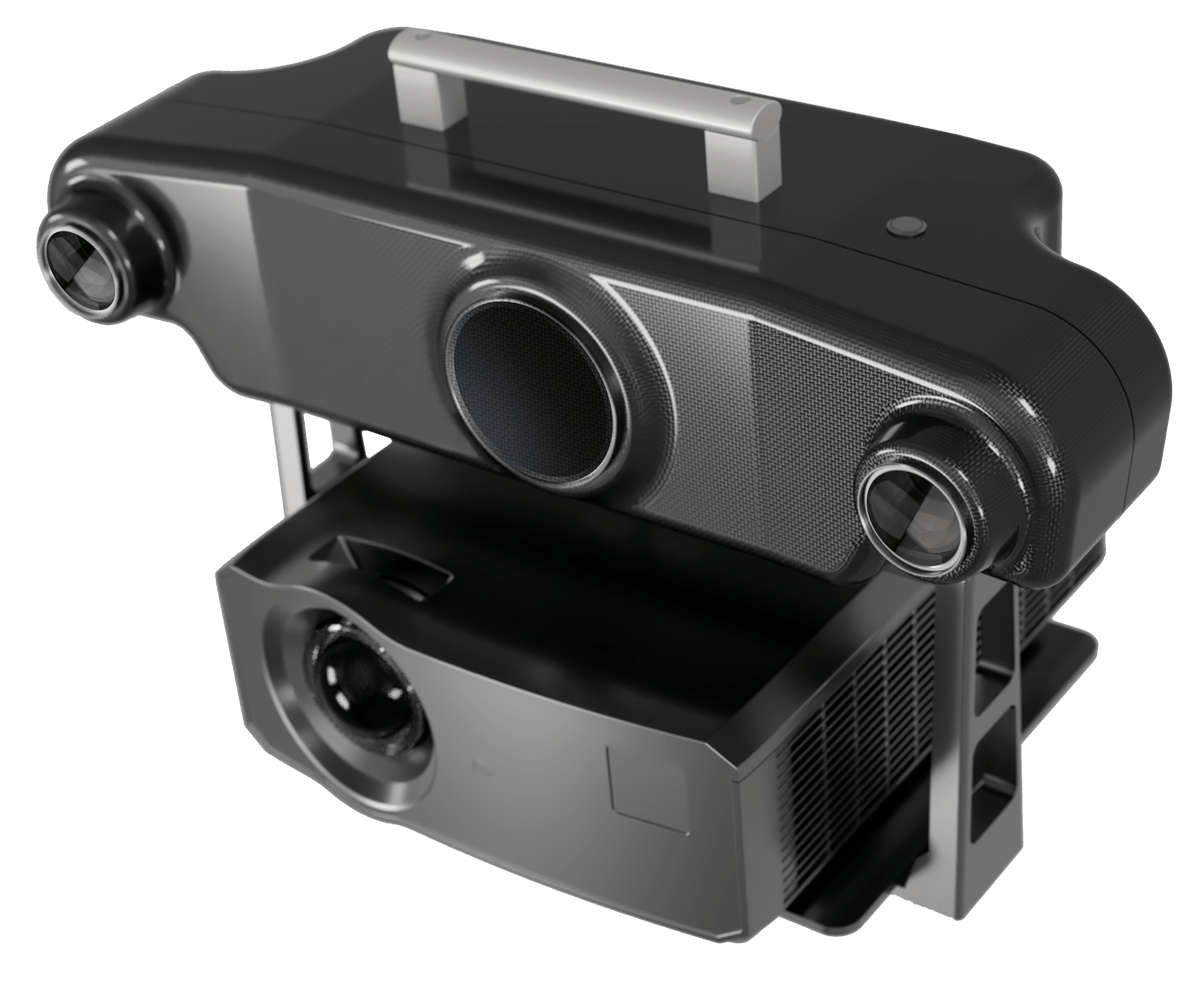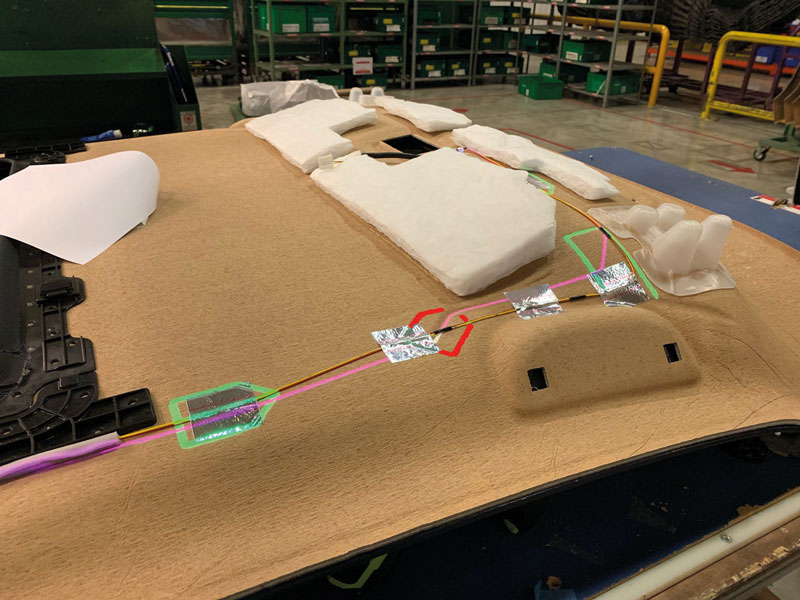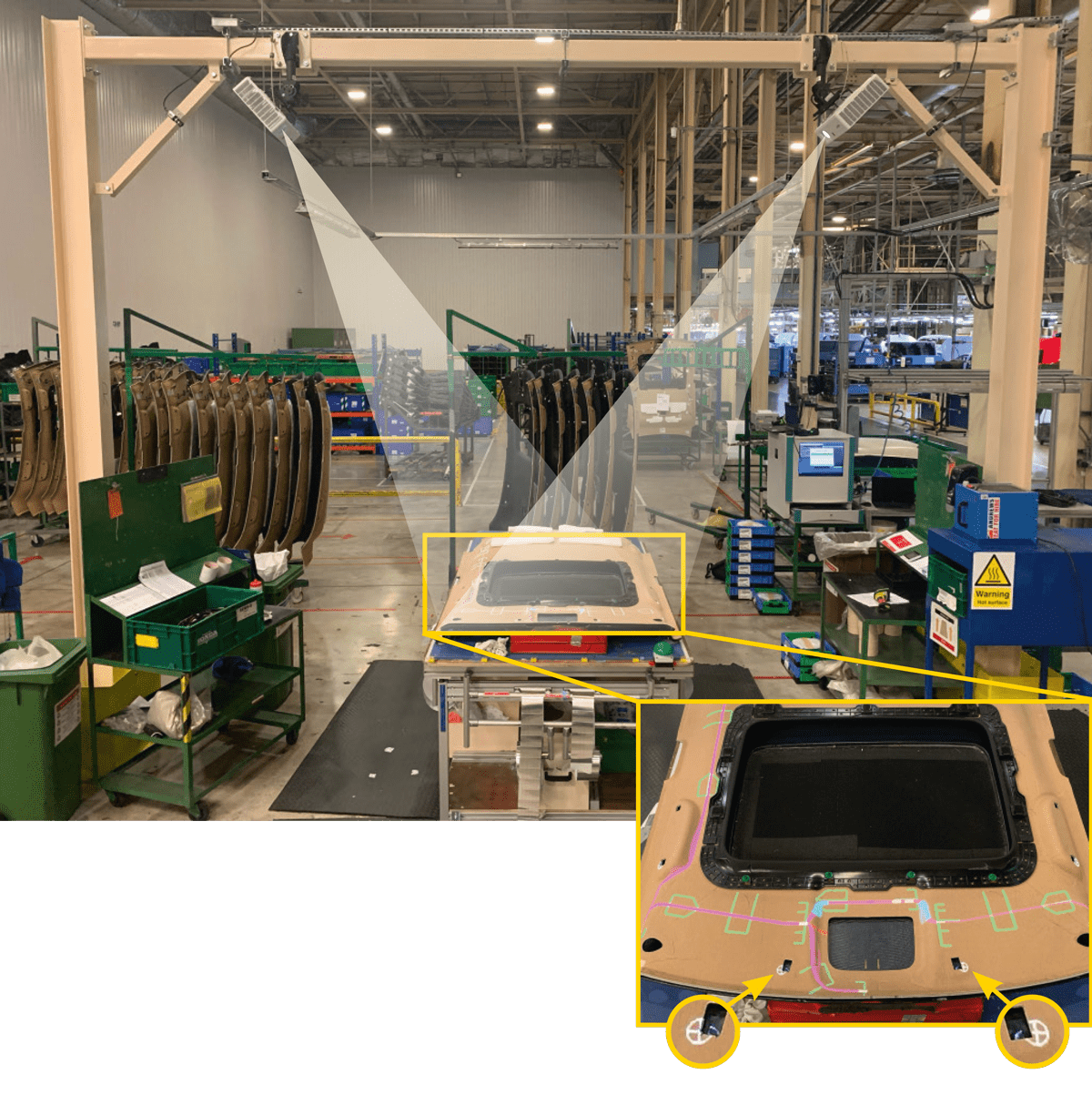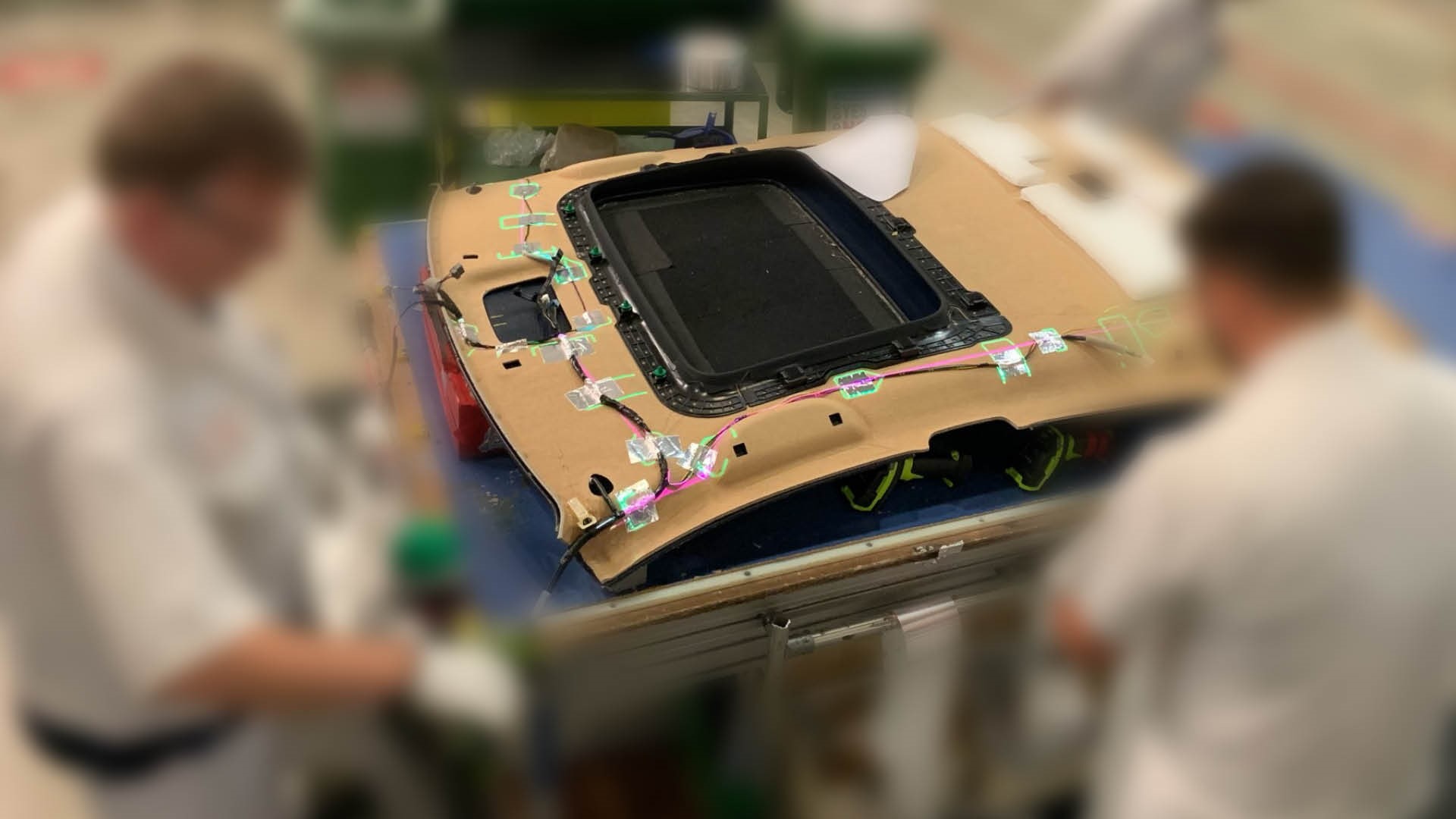What is dynamic video projection in the industry?
Video projection is used in a wide range of industrial sectors wherever complex 3D information needs to be visualized on components. Using a calibrated video projector or beamer, production or CAD data from the production system is projected precisely onto moving components and, depending on the work step, displayed to the worker as an animated step-by-step sequence or simultaneously across the work process. In this way, manual work that still has to be carried out, for example in assembly or quality assurance, can be done faster, more precisely and more reliably. Video projection thus supports flexible production within a modern production environment characterized by a high diversity of variants and ever shorter production cycles. It also serves as a means of communication for error analysis. Here, it displays the measurement data determined by optical or tactile measuring devices as false color or deviation maps or as individual point measurement values on the component surface.
Design processes are also greatly facilitated thanks to it, as employees can use it to quickly identify possible sources of interference across different teams, thus improving traceability for all involved.
By using image processing and tool tracking, these applications can be usefully extended – for example, by gesture control, control of add-on parts and automatic forwarding of projection content. This means that analog process data can be directly recorded during the machining process and automatically fed back into the digital twin.
What are the general advantages of video projection for industrial and manufacturing applications?

Dynamic 3D video projection supports manufacturing by visualizing complex information in the context of components or workpieces. It can be installed cost-effectively and offers high added value, because it eliminates the need for blueprints, templates, inspection equipment, and time-consuming manual marking with point marking machines or measurement systems. Physical mockups are also reduced thanks to augmented reality projection. This leads to shorter decision-making paths in manufacturing based on clear and accurate information.
Work processes also run more efficiently, because thanks to video projection, workers on the production line not only receive precise work instructions on how and where a
component must be assembled or machined. It also clearly teaches them new work processes and hand movements, significantly reducing the need for training while increasing transparency and continuity in manual processes. In quality assurance and design, 3D video projection helps production teams to communicate measurement results and other complex content in a comprehensible and tangible way across departmental boundaries. This lays the foundation for consistently high quality and, as a result, higher customer satisfaction.
Advantage: Video projectors visualize 3D information in the correct position on components

How is this integrated into manufacturing?
Dynamic video projection facilitates and optimizes processes by visualizing complex 3D information in the context of a component. Often, such a solution must be integrated into the process automation logic of the production in series processes. Via a platform-independent web interface, WERKLICHT can receive its commands, for example, from the host computer, an MES (Manufacturing Execution System) or another control system. The OPC UA interface (Open Platform Communications Unified Architecture), which offers particular flexibility in data exchange and is the most suitable solution for connecting the control technology or conveyor technology, which are typically coordinated by programmable logic controllers (PLCs), should also be emphasized. With the help of this internationally recognized standard, EXTEND3D solutions can be even better integrated into the production line. The effort required for adaptation to third-party systems is reduced to a minimum.
How do users get from data to projection?
Flexibility is crucial when generating the actual projection content. For this reason, WERKLICHT supports, among others, all CAD and 3D formats commonly used in the industry.
Task-specific formats can also be easily integrated via a generic CSV exchange interface. The corresponding projection content can be generated from these manually or automatically. Once the sources have been connected, users only have to select the required data or the job files already stored by the work preparation department in the software – with connection to the automated conveyor system or recording of the components by barcode scanners, this can also be fully automated.
Data from manual processing flows back into the digital model
The interaction of dynamic video projection and tool tracking or 2D/3D image processing makes it possible to seamlessly link analog and digital processes. The video projector brings digital information into the analog world. Via 2D/3D image processing or tool tracking, data from manual processing then flows back into the digital model, the so-called digital twin. In this way, the projector knows that a work step has been completed, hides it or switches to the next work step. In this way, the manufacturing process from design to quality assurance can be represented completely digitally and a 100 percent digital process chain can be achieved.
How does scalable, dynamic 3D video projection work?

The basis of WERKLICHT video projection systems are commercially available video projectors, which are mobile or statically fixed in the production environment and controlled by WERKLICHT 3D software individually or in a network. In the first step, customers first check whether the use of video projectors is suitable for the components in question. This is because video projection works best on matte and bright surfaces. The conditions in the production hall also play a role. Laser projection may be more suitable for very dark or reflective surfaces or in very bright environments.
The following parameters are decisive for the selection of projectors:
- Size of the area to be illuminated: In mobile systems, relevant areas can be processed sequentially by moving the projector on the stand, which makes sense especially for complex-shaped components or generally for longer cycle times. With static systems, on the other hand, the entire work area must be considered. The required number of projectors can be determined as part of a simple simulation.
- Ambient brightness: The clear display of the projection depends on the ambient brightness. Typical workplace lighting of approx. 500 lux is usually unproblematic; however, sunlight in the relevant area in particular should be minimized. Artificial lighting can also be dimmed or switched off in the relevant areas to improve the contrast of the display. In this case, the illumination is provided by the projector itself: It projects the information to be displayed inversely, i.e. dark against a white background. This is usually the more cost-effective solution, because high-intensity projectors are more expensive.
- Required precision: Video projection works mathematically with sub-pixel accuracy. Nevertheless, the display accuracy depends on the size of a single pixel, which is either illuminated or not. Accordingly, the precision of the display can be increased either by using a higher resolution or, alternatively, by using more projectors with correspondingly smaller working areas.
- Possible working distances: The spatial situation is decisive for the installation of the video projection system. For example, additional installations such as crane runways or low hall ceilings limit the space where projectors and cameras can be mounted. WERKLICHT 3D offers a variety of options that can be adapted to the individual requirements of a workspace.
To achieve precise display, commercially available video projectors are intrinsically 3D calibrated using a special mathematical procedure before use. In static environments, this only needs to be performed once on site as part of the assembly process. For dynamically moving components or for automated quality inspection of manual assembly steps, additional cameras are integrated into the environment. For mobile projection systems, the projector is combined with a special WERKLICHT stereo camera system. By means of the cameras, the intrinsic 3D calibration of the system can be repeated at any time, for example if the zoom or focus settings of the projector have been changed. In the case of several projectors, the extrinsic composite calibration is also performed automatically at the same time via the cameras.
For dynamic video projection of the relevant information, the projectors are calibrated to predefined reference points on the component. Both the projectors and the component can then be moved, as the projection automatically adjusts to the changed position using marker-based/markerless tracking. This makes the system very mobile and flexible. 3D data serves as the basis for the projection on the component. All common CAD formats can be used here, as well as CSV files or measurement and simulation data. These data are imported directly from the production system into special software via a standard interface. The WERKLICHT 3D software is capable of visualizing the CAD, measurement or simulation data at the click of a button. This allows users to immediately convert their data into projections and use augmented reality without first requiring a high level of programming effort – this also works fully automatically.
In addition, 2D data can be used, for example, to display additional information on the component or the work table next to the component. In this way, ad hoc information or content can also be added without a direct spatial reference to the component.
Two typical application scenarios are shown below.
Dynamic video projection in practice

Video projection makes positioning and dimensions visible directly on the component, which are only available as data in the production system. 3D visualization helps manufacturing teams avoid errors in the production process and perform even complex tasks efficiently. It also supports faster decision-making, for example in defect analysis. Since measurement data and deviations are visible directly on the component, the facts become comprehensible for everyone involved and discussion in the team becomes easier.
Example of static video projection solution: positioning and wiring of cable harnesses
One example of a static solution is the correct positioning and cabling of cable harnesses on headliners. Here, the headliner lies reproducibly in a fixture on a table and two projectors are statically attached to a crossbeam above it. The video projectors are aligned in such a way that no movement or manual alignment on the part of the workers is required, as they illuminate the entire component. Via a barcode on the headliner, which is scanned by the responsible worker, the WERKLICHT 3D software recognizes which variant of the workpiece is present, so that the corresponding projection can be displayed immediately. For each new product variant, the corresponding projection contents must be stored once in the project. For a large number of product variants, even this one-off teaching process can be fully automated, provided that the CAD data is structured sensibly via the structure tree or layer. Employees are guided in their work steps primarily by audio-visual instructions. Additional cameras provide automatic documentation of manual assembly steps for quality purposes. The long-life projectors, which are designed for 24/7 operation, are referenced via six features each, which were defined in advance during work and data preparation for the respective headliner on the basis of the CAD model and can be aimed at by means of projected crosshairs.
The referencing can be easily corrected at any time by moving the crosshairs by remote control, should the position of the WERKLICHT projectors change slightly, for example due to temperature fluctuations over the course of the year.
The solution is already being used by a Japanese car manufacturer.
Example of a dynamic video projection solution: The measurement data visualization on the Meisterbock and cuibing
In automotive production, it is common practice to first match the individual components of a vehicle precisely to one another on the so-called Meisterbock and cubing. This involves dimensional accuracies in the tenth of a millimeter range. With the WERKLICHT solution, any deviations previously determined by tactile or photogrammetric coordinate measuring technology can be visualized directly and intuitively. The measurement data is simply exported from the measurement software in CSV format or as network data and imported into WERKLICHT3D. In this case, the video projection solution is mounted on a mobile tripod or on a swivel arm and is moved dynamically around the component. Already measured coded or uncoded markers can be used directly as the basis for referencing. Their coordinates, like the measurement data itself, are simply transferred from the measurement software. Alternatively, however, an RPS alignment via control geometries is also possible, which can be easily configured in WERKLICHT3D on the basis of the CAD data. To audit the assembly, the system projects either large-area measurement logs as false colors, or point-by-point deviation data or particle measurement values. The visualization depends on the application. For example, in the case of gap flushness, individual numerical values are displayed along the gap. The CAD data of the components can also be projected, so that the ideal condition is visible and vivid for everyone involved. Thanks to dynamic referencing, the projection always remains in the correct position and continuously adapts to the component position.
FAQs
Frequently asked questions about video projection in the industry
